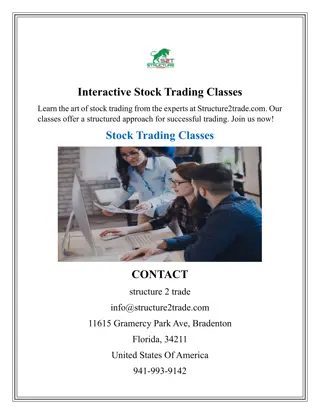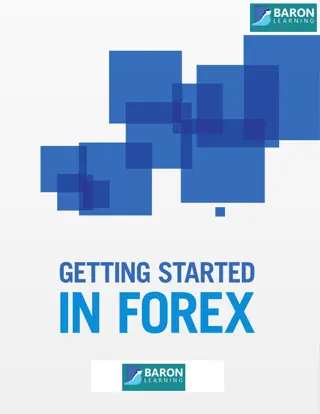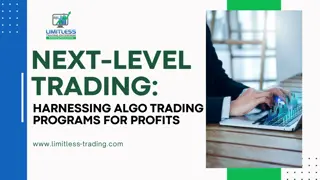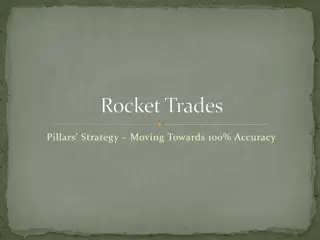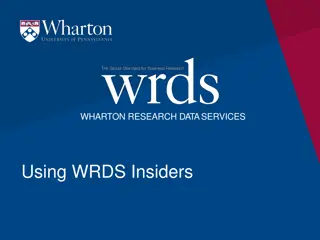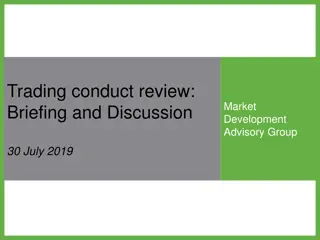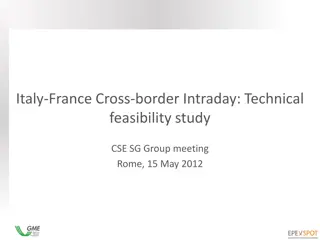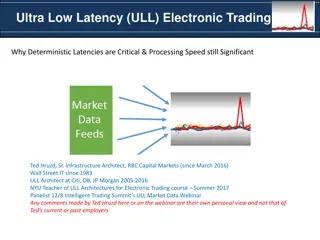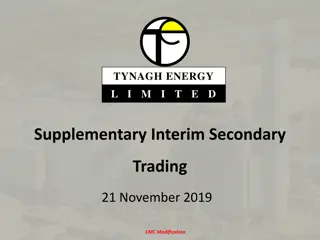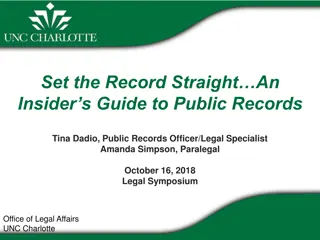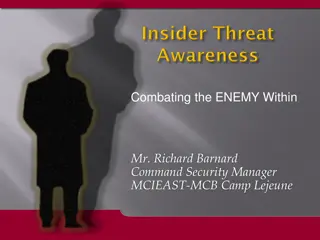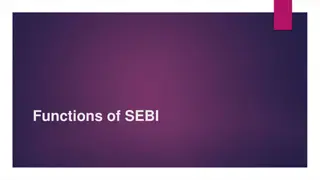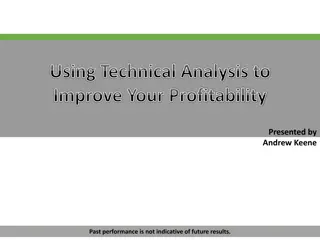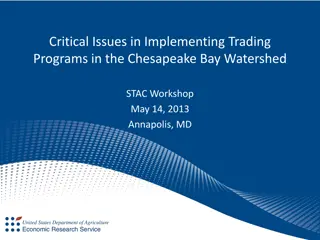Overview of Insider Trading Laws and Notorious Cases
Insider trading, involving the trading of securities based on confidential information, is prohibited under various statutes such as Section 10(b) of the Securities Exchange Act of 1934 and SEC Rule 10b-5. The Insider Trading Sanctions Act of 1984 and the Insider Trading and Fraud Act of 1988 provide penalties for such illegal activities. Notable insider trading cases include William Duer's involvement in the Panic of 1792 and the more recent case involving Dennis Levine, Martin Siegel, Ivan Boesky, and Michael Milken.
Uploaded on Sep 06, 2024 | 1 Views
Download Presentation

Please find below an Image/Link to download the presentation.
The content on the website is provided AS IS for your information and personal use only. It may not be sold, licensed, or shared on other websites without obtaining consent from the author.If you encounter any issues during the download, it is possible that the publisher has removed the file from their server.
You are allowed to download the files provided on this website for personal or commercial use, subject to the condition that they are used lawfully. All files are the property of their respective owners.
The content on the website is provided AS IS for your information and personal use only. It may not be sold, licensed, or shared on other websites without obtaining consent from the author.
E N D
Presentation Transcript
A. Illegal Insider Trading Unfair capital markets fail to draw capital. Illegal insider trading is traditionally defined as the execution of transactions on the basis of material non-public information. Several statutes are generally relied upon to enforce prohibitions on insider trading. Section 10(b) of the Securities Exchange Act of 1934 prohibits the employment in connection with the purchase or sale of any security registered on a national securities exchange or any security not so registered, any manipulative or deceptive device or contrivance in contravention of such rules and regulations as the Commission may prescribe as necessary or appropriate in the public interest or for the protection of investors. SEC Rule 10b-5 prohibits any act, practice, or course of business which operates or would operate as a fraud or deceit upon any person, in connection with the purchase or sale of any security. These rules are extended to identify elements of a Section 10(b) or Rule 10b-5 insider trading claim: Possession of material nonpublic information; Trading while in possession of that non-public information; Violation of a relationship of trust and confidence Section 14 of the Securities Exchange Act and Rule 14e-3 impose a disclose or abstain from trading obligation on any person who trades in securities that will be sought or are being sought in a tender offer, while that person is in possession of material nonpublic information that he knows or has reason to know has been acquired directly or indirectly from the offer or, the subject corporation The Securities Exchange Act of 1934 (Section 14e) provided for the initial federal statutory insider trading restrictions, though a 1909 Supreme Court decision in Strong v. Repide interpreted inside trading by corporate officials without appropriately revealing that information to be a form of fraud. A 1980 Supreme Court decision (Chiarella v. United States) defined an insider as one who maintains a "relationship of trust and confidence with shareholders". The Insider Trading Sanctions Act of 1984 authorized penalties for illegal insider trading equal to three times the illegally obtained profits plus forfeiture of the profits. The Insider Trading and Fraud Act of 1988 was intended to help define exactly what constitutes an insider and to set penalties for illegal insider trading activity.
Notorious Insider Trading Cases All of the individuals named in the cases that follow were very successful in their businesses, and in most cases, quite wealthy. William Duer was appointed Assistant Secretary of the Treasury in 1789 under Alexander Hamilton. Duer used information and connections obtained in his official position, along with substantial leverage to speculate in new U.S. debt and various bank stock issues. His speculation and subsequent failure was a major cause of the Panic of 1792. In 1985, Dennis Levine, an M&A specialist was a managing director at Drexel, Burnham Lambert. One of his trading account brokers, a Bahamian subsidiary of a Swiss bank began "piggy backing" off his trades as did the bank's account executive at Merrill Lynch. Merrill Lynch became suspicious of these trades and notified the SEC. Levine implicated fellow M&A specialist Martin Siegel and Ivan Boesky, to whom he had passed illegal trading tips. Boesky, considered the leading expert on merger arbitrage, had been paying Levine a percentage of his trading profits gained from Levine's tips. Boesky agreed to a plea, whereby he implicated Michael Milken and Drexel Burnham, along with his friend, John A. Mulheren Jr., the former head of Jamie Securities. The investigation into the relationship between Boesky and Milken uncovered a $5.3 million payment in 1986 to Drexel that Boesky had characterized as a consulting fee. A significant amount of other evidence of insider trading was uncovered, but the bulk of the SEC's weak case against Milken and Drexel would be based on the testimony of Levine, Boesky and other convicted felons. The SEC began to focus on Milken's brother Lloyd, who might have played a minor role in the insider trading activities and other relatives, including their 92 year-old grandfather. Milken agreed to a plea arrangement. A codefendant of Milken, Alan Rosenthal, took his case to trial, whereby it was tossed by the judge before going to jury, lending significant credibility to the argument that the case against Milken was weak. Levine received a two year sentence, was fined $362,000 was disgorged of $11.5 million in illegal trading profits and paid an additional $2 million in back taxes. Boesky served two years in prison, paid $100 million in fines and was barred from the securities business for life. Milken received a ten-year sentence for fraud and illegal market manipulation, which was later reduced to 24 months, fined $600 million and made restitution payments. Milken and other Drexel employees paid $1.3 billion into a pool to settle hundreds of lawsuits. Drexel was ultimately bankrupted in the aftermath of the scandal, fines, loss of reputation and the collapse of the junk bond market.
More Notorious Insider Trading Cases Martha Stewart sold approximately 3,928 shares of ImClone, which had just learned that its new prescription drug would not obtain FDA approval. After learning about the drug's setback, Sam Waskal, CEO of ImClone quickly sold shares of his ImClone stock. His broker, Peter Bacanovic, who also served as Martha Stewart's broker, apparently notified her that Waskal was selling shares of his company's stock. The SEC investigated Bacanovic and Waskal, who were ultimately imprisoned. Whether Stewart had engaged in illegal insider trading was not known at this point, and still is not completely clear. Even if Ms. Stewart had been completely forthright about the information that she had received and why she sold, the SEC's case against her would have been weak at best. Ms. Stewart conspired with Bacanovic to fabricate a story about a stop order at $60, leading to charges of conspiracy, obstruction of an agency proceeding, and making false statements to federal investigators. She was convicted and sentenced in 2004 to serve five month in federal prison followed by five months of incarceration in her Bedford home and two years period of supervised release. She also paid a fine and disgorged the reduction in short-term trading losses that she avoided. After she was charged in the alleged insider trading incident involving ImClone, but before the general public knew of the investigation, Ms. Stewart sold shares of her own company, Marta Stewart Living Omnimedia, Inc. This exposed her to additional insider trading charges. She was charged for manipulating the price of her company's stock. These charges did not result in convictions. In 2011, Raj Rajaratnam, billionaire and founder of the defunct hedge fund, the Galleon Group, began serving an 11 year sentence in the Federal Prison system after being convicted on 14 counts of conspiracy and fraud. This was the longest sentence ever imposed for illegal insider trading. Mr. Rajaratnam was also fined $92.8 million and will face civil and other actions. Mr. Rajaratnam had been accused of having taken more than $50 million in insider trading gains based on tips provided by fellow conspirators at Goldman Sachs, McKinsey & Co., Intel, Google, etc. Among those implicated in the investigations were Roomy Khan (Intel), Anil Kumar (McKinsey), Danielle Chiesi (Bear Stearns), Zvi Goffer (Galleon), Rajat Gupta (McKinsey and Goldman Sachs), Robert Moffatt (IBM). Two interesting facets of this case were the large number of co-conspirators (49, more or less) and the use by authorities of wire and tapes to record conversations, including more than 40 wiretapped phone conversations between Mr. Rajaratnam and his accomplices.
Monitoring Inside Trading Activity Successful insider trading prosecutions usually require cooperation from codefendants or damaging information concerning other illegal behavior (such as tax evasion). There have been recent improvements to enforcement efforts. Surveillance techniques have improved significantly. The SEC, all of the major markets and companies themselves are purchasing software systems to monitor for illicit activity. The SEC is making use of more resources to monitor insider activity, including formation of special surveillance teams, wire tapping and payments of bounty to informants. The SEC currently contends with roughly 700,000 tips per year from informants. Markets such as the NYSE, Nasdaq and CBOE are making greater use of technology to monitor trading activity for suspicious activity. FINRA has been using an intelligent surveillance application known as the Securities Observation, News Analysis and Regulation (SONAR) system to detect suspicious patterns. Regardless, insider trading enforcement remains difficult.
B. Front Running and Late Trading Front-Running occurs when a broker uses his knowledge of a large pending order to buy (sell) the relevant security in front of the pending buy (sell) order so as to benefit from the market reaction to the large order. In one front-running scandal, the U.S. Attorney's Office and the SEC accused brokers from Merrill Lynch of allowing certain clients to listen to conversations involving other clients through broadcasts on Merrill Lynch internal speaker systems. In this Squawk Box Scandal, some clients were privy in advance to other clients trades. A similar, often legal, but frequently unethical practice is tailgating, a form of parasitic trading where the broker places an order immediately after the client s order. Another type of ethically questionable parasitic order is penny-jumping, where the broker places a buy (sell) order one uptick above (downtick below) below the client s buy (sell) limit order, expecting to benefit either from the market s reaction to the client order or to limit his losses by transacting with the client. For example, if the client were to place a large buy order at 50.00, the broker would penny jump by placing her buy order at 50.01. The broker s order will execute ahead of the client s order due to price priority. If the client s order then executes, the broker will profit from any favorable price reaction due to the client s large buy order. If the price declines, the broker can quickly sell his shares to the client at a $.01 loss.
Market Timing and Late Trading Market timing is the fund trading strategy intended to exploit stale security prices and NAV deviations from fundamental values. While market timing is not illegal, it can transfer wealth between fund shareholders and necessitate that funds maintain higher levels of cash to accommodate share redemptions. In 2003, New York State Attorney General Elliot Spitzer filed a complaint against the New Jersey based hedge fund Canary Capital Partners, run by Edward Stern. Spitzer s complaint alleged that Canary Capital entered into illegal agreements with mutual fund companies to defraud investors. For example, Canary made a secret agreement with Security Trust to enable it to engage in market timing-related trades. In another case, PIMCO agreed to permit Canary a specified number of trades in exchange for fees to be earned on $25 million it would manage for Canary. Spitzer also accused Canary of late trading. Apparently, Canary maintained arrangements with funds to purchase or redeem shares after daily NAV s were computed. Late trading is always illegal. Late trading was described by Spitzer as betting on a horse race after the horses have crossed the finish line. According to Spitzer s complaint, Canary purchase mutual fund shares after 4 p.m. exchange closing times with the assistance of certain Bank of America fund employees. Technically, Canary allegedly submitted trades in question prior to the 4 p.m. deadline so that they could be time-stamped before 4 p.m. However, Spitzer alleged that the Bank of America employees would hold transactions until after the market closed, providing Canary the opportunity to confirm its trades. Bank of America employees purportedly reconciled the late trades the following day. Canary settled Spitzer s complaint for $40 million and was permitted to not admit guilt. Bank of America provided compensation to its mutual fund shareholders for related losses. Spitzer and the SEC also charged Janus, Bank One's One Group, and Strong Capital in other alleged incidences of late trading. The founder and chairman of Strong Mutual Funds, Richard Strong was charged with late trading in his own fund.
C. Bluffing, Spoofing and Market Manipulation Bluffing is the act of fooling other traders into making unwise trades by convincing them that the bluffer has superior material information about security values. There are a number of ways that traders bluff, both legal and illegal. A trader can bluff the market by placing a bid or offer at a price or in a quantity that exaggerates his or her own true position, interest or lack of interest in a security. For example, a bluffer might place a particularly attractive offer for a small quantity of shares, intending then to sell a much larger quantity of shares after a positive price response to the initial offer. As long as such orders are executed, they are usually perfectly legal. Bluffers may also simply spread rumors or false information about the value of a company s shares. Such false rumor spreading can represent deceit or fraud, illegal when used to manipulate markets, and perhaps otherwise as well. Spoofing is the act of placing a quote that is intended to be canceled prior to its execution. Spoofing might be considered a form of bluffing where the trader places a trade that she has no intent to execute. Motivations behind spoofing: to overload the quotation system of a market, inhibiting its ability to execute trades, to delay a specific trader's trade execution by placing that trader's quotes behind a series of quotes with higher priority, to create the appearance of false market depth or direction, particularly by submitting then later cancelling multiple bids or offers. This type of spoofing is often referred to as layering. Layering is frequently accomplished through an HFT program designed to submit many quotations that are canceled after an executed transaction. Orders, modifications, and cancellations are not considered to be spoofing if they were submitted as part of a legitimate, good-faith attempt to execute a trade. In 2001, the SEC alleged that Alexander Pomper submitted a phantom limit order on NASDAQ to purchase 300 shares of the thinly-traded Gumtech International ( GUMM ) at $11.375. This limit order improved the NBBO bid by $.3125 from $11.0625, while the NBBO offer was $11.4375 per share. Pomper improved the bid for GUMM, but with a bid that he apparently did not actually intend to fill. Then, Pomper placed an order to sell 2000 shares of GUMM at $11.375 per share through another market making firm. Pomper's sell order was immediately executed at $11.375 per share because the best bid at $11.375 seemed to suggest a higher value and more liquid market for GUMM. However, after executing its sell order, Pomper canceled his order to buy GUMM for $11.375, realizing a profit of $625 (2,000 [$11.375 - 11.0625]) relative to the initial bid for $11.0625. In 2002, the SEC announced a settlement with Pomper, whereby Pomper agreed to pay $9,800 in disgorgement and prejudgment interest and to pay a $15,000 civil penalty.
Corners and Pools Corners involve the purchase a sufficient level of a given security to obtain market power over its price. The purpose of the corner is to manipulate the price of the security. Numerous corners have existed over the years in commodity and securities markets. The Hunt brothers (Nelson and Lamar), two of the then wealthiest men in the world, attempted to corner silver markets in the early 1980s. Although they succeeded in bidding up the price of silver almost ten-fold, the bottom fell out of the market before they could unload. They nearly went bankrupt. A Pool is a common fund comprising participants combining their resources to obtain a large position in a security in order to manipulate its price. Pools are typically used to facilitate cornering of a market, and were a common activity prior to the 1929 stock market crash. Commodore Cornelius Vanderbilt and Daniel Drew, an operator with connections to Tammany Hall Vanderbilt owned enough shares (with a cost as low as $8 per share) of Harlem Railroad Company stock to effectively control the company He intended to extend the railroad's service into Manhattan and required approval from the city. However, Daniel Drew, sold his shares and shorted 137,000 shares, almost 5 times the number of outstanding shares. He used his influence to convince Boss Tweed to repeal the railroad's license to operate in New York City, intended to ruin the railroad. The price of shares fell from $100 to $72, with Vanderbilt purchasing shares as Drew sold. Vanderbilt had, in effect, purchased the company several times over by acting as counterparty on Drew's short sales Drew needed to cover his short positions by repurchasing the stock. But only one major investor owned shares - Vanderbilt. Vanderbilt, having cornered the market, set his price at $179 per share, a price calculated to be the maximum that Drew could pay. Vanderbilt obtained his approval to extend the railroad into Manhattan and Drew was practically bankrupted in the process. Drew had fallen victim to a market corner, intended to squeeze the short seller.
More Corners and Pools Two brokers employed by Moore & Schley, Cameron & Co. were accused in the 1980s of acquiring shares of Chase Medical Group to inflate prices. These brokers were accused of cornering the market and engaging in phony transactions to prop up the share prices. In the height of the financial crisis of 2008, Porsche revealed that it owned 42.6 percent of the stock of Volkswagen, along with call options on another 31.5%. The state of Lower Saxony in Germany owned another 20%, which it did not want to sell, creating a shortage of shares in the market available for short sellers to cover their positions. This shortage of available shares caused the share price to rise from about 200 Euro to over 1,000. In effect, without breaking German securities law, Porsche had, cornered the market for Volkswagen shares and squeezed hedge fund short sellers, earning significant paper profits. No bidder was permitted to bid for or obtain 35% or more of a given Treasury issue. In 1991, Salomon Brothers routinely bidded on more than 35% of issues, illegally bidding on as much as 105% of certain new issues. To conceal their actions, many bids were parked under names of clients. Such overbidding enabled Salomon to corner the market and fix prices for new two-year treasuries. The Treasury responded to this scandal by expanding its list of primary market participants and changing bidding procedures. Solomon fired its CEO, John Geutfrend and several key employees including John Meriwether and Paul Mozer. Mozer subsequently pleaded guilty on two counts of lying to the Federal Reserve Bank of New York in his bid submissions, served 4 months in a minimum security prison, and was fined $30,000 and an additional $1,100,000. Warren Buffet, who owned a substantial stake in the firm through his holdings in Berkshire-Hathaway, contributed significant credibility to the firm by taking over as interim CEO.
Wash Sales Wash sales are sham transactions intended to create the appearance of sales where, in effect, no sales actually take place. The SEC defines a wash sale as a transaction that involves no change in beneficial ownership. Wash sales may be intended to manipulate security prices (e.g., conspirators execute transactions with one another to create records of sales prices to deceive other participants in the market). A series of wash sales at ever-increasing prices, known as a jitney game, can give other investors the impression that the value of the security is rising, leading investors to purchase the stock. Wash sales may also involve the sale of securities for tax purposes with offsetting transactions to repurchase the securities or related instruments. The I.R.S. defines a wash sale to be a sale and a re-purchase of the same security within 30 days. This sort of wash sale is not illegal, though any capital losses and associated tax write-offs generated by this activity will be disallowed by the I.R.S.
Fishing Fishing refers to a practice intended to obtain secret or hidden information concerning order sizes in dark pools. Fishing occurs when a trader (who might also be called a "gamer" in this setting) sends a series of small orders to a dark pool to detect whether there is a large order waiting in that pool. If the fishing results in successful order fills, the trader might infer that additional orders or a very large order await in the pool. Then, the trader can submit a much larger order at a size and price that reflects the information that he has obtained through his gaming activities. Suppose that an institutional trader has discretion reflected in his algo to buy shares at a price as high as 50.03 and places a bid at 50.00. The current market for the shares is 50.00 Bid / 50.05 Offer. A fisher or gamer detects this algo order, but does not know its reserve price to purchase shares. The gamer pings the algo by offering shares at 50.04. If the offer is not immediately executed, it immediately cancels. Then, the gamer offers 50.03 and the institutional algo buys. The gamer now knows that it can probably sell many more shares at 50.03 rather than the 50.00 quoted bid. Thus, the gamer submits a much larger sell order at 50.03. This sort of gaming activity is often perfectly legal. An important exception to the Quote Rule is the fill or kill order. These quotes are often not publicly displayed, but may be displayed to select clients. These flash orders can result in flash trading in advance of the public quote stream. Such flash orders can facilitate fishing and have been criticized as being very unfair to the majority of market participants. Predatory algo trading strategies are designed to exploit other institutional algo orders. Suppose the predatory trader detects an institutional algo order to buy a large number of shares These shares are offered at 50.00, and the predatory trader suspects that the institution has pegged its order to the NBBO and is willing to pay as much as 50.25 per share. The predatory algo can seek to lock in a profit by artificially increasing the share price. Upon detection of this institutional order, the predatory trader places a small bid of 50.01, then continues placing small bids at successively higher figures as the institutional algo trader increases its bid with the NBBO. Ultimately, the predatory places a short sell order at 50.25, knowing that it created much of the apparent demand running the price up to 50.25. When the price falls, the predatory algo covers its short position.
Other Quote Abuses Quote matching occurs when a small trader places a quote one tick from that of a large trader so as to profit from the large trader's transaction price pressure, or to use the large trader as a counterparty should prices reverse. Quote matching exploits the option associated with a limit order Quote stuffing is the placement of large numbers of rapid-fire stock orders, with most or all of which being canceled almost immediately, frequently for the purpose of clogging trading HFT and other algorithms and data computations. The purpose of quote stuffing is not to execute orders, but to sabotage algorithms of other traders. Some dealers post quotes that are very distant from any reasonable market price for the security (e.g., bid for $.01 or offer at $100,000), not intending or expecting that these quotes would ever be executed. However, in a one- sided market, these "stub quotes" quotes might be executed against as liquidity dries up, causing securities to trade at absurd prices.
D. Payment for Order Flow Many exchanges and markets will provide rebates on orders that create liquidity, which essentially represents payment for order flow. This system, also known as make-or-take pricing, refers to exchanges allowing patient traders to post standing limit orders that await execution until some other trader takes the other side. In effect, the patient trader is a market maker who receives payment from the exchange for making the market (liquidity rebate) and the market taker pays an access fee. Note the connection between this system and the "immediacy argument" of Demsetz A number of observers have noted that make-or-take pricing systems have reduced spreads and improved liquidity, though the liquidity rebates normally are not reflected in bid and offer quotations. Such payments and rebating for order flow might lead to market abuses, reduce price competition for securities and reduce security price transparency. Some observers argue that the customer may lose the opportunity to obtain an unannounced better price from a broker on the national exchange floor. The SEC adopted Exchange Act Rule 11Ac1-6 (now SEC Rule 606), requiring broker-dealers to make available quarterly reports that present a general overview of their routing practices.
E. Fat Fingers, Hot Potatoes and Technical Glitches In 2005, a novice trader in a subsidiary of Mizuho Financial Group, attempted to sell one share of J-com stock on the Tokyo Stock Exchange for 610,000 ($5,041). By accident, he transmitted an offer to sell 610,000 shares at 1 each. In effect, he attempted to sell $3.075 billion worth of stock for $5,041. These 610,000 shares that he attempted to sell represented 41 times the total number of J-com shares issued by the Japanese recruitment company. Mizuho attempted to cancel and reverse the order, but not quickly enough, such that this incident (losses exceeding 27 billion) wiped out Mizuho's entire profit for the quarter. The absence of filters either at the bank or at the Tokyo Stock Exchange to prevent such an obviously erroneous trade played havoc with the market for J-com stock, and caused the entire Nikkei-225 to drop by 1.72%. The broader market reaction was largely in response to traders attempting to guess which firm had made the mistake, driving down share prices for nearly all Japanese financial institutions. Later litigation assessed a significant portion of the blame on the Tokyo Stock Exchange, and Mizuho recouped some of its losses. A trader at Bear Stearns caused a 100-point drop in the Dow after inadvertently entering a $4 billion sell instead of his intended $4 million buy order. Morgan Stanley made a similar mistake with a 2004 order for $10.8 billion rather than the intended $10.8 million. Washington Post Co. dropped by 99% in less than one second on June 16, 2010 on NYSE Arca and Progress Energy Inc. increased by 90% in less than one second on September 27, 2010 on NASDAQ. Nikkei 225 futures contracts dropped by 1.1% on June 1, 2010 as a result of an unintentional algo-order placed on the Osaka Stock Exchange. Each of these occurrences illustrates the need (and failures) for effective trade filters, even in the absence of automatic algo executions.
The Flash Crash On May 6, 2010, the "Flash Crash, often been blamed on High Frequency Trading caused the Dow Jones Industrial Average to drop almost 1,000 points in less than 30 minutes before recovering almost as quickly. Trades were executed at absurd prices, ranging from less than one cent to over $100,000. Exchanges ultimately canceled over 20,000 executions. An SEC report noted that the crash was preceded by a rapid algo-initiated short, reportedly by mutual fund group Waddell & Reed (not an HFT), of a $4.1 billion block of E-Mini Standard & Poor s 500 futures contracts on the Chicago Mercantile Exchange. However, HFT firms apparently were counterparties to these shorts, and immediately covered themselves by further shorting (turning the contracts into hot potatoes), drying up liquidity in these markets. Within 20 minutes of the start of the "crash," trading in the E-mini contract was halted for five seconds, which allowed the market to recover. When contract trading resumed, prices quickly recovered most of their losses. An important lesson from this and other mini flash crashes is that high trading volume and market liquidity are not the same, especially when hot potato volume is involved.
Hot Potato Volume Hot potato trading, repeated passing of inventory imbalances among dealers seems to actually dilute the information content of trading. This type of trading tends to be more common in the presence of HFTs and where interdealer volume is high.
A Textbook for $23,698,655.93 (Plus $3.99 Shipping) Consider Peter Lawrence s 1992 developmental biology textbook, The Making of a Fly: The Genetics of Animal Design. Michael Eisen, an evolutionary biologist at the University of California reported that he sent one of his post-docs to purchase a copy on Amazon.com Amazon listed 17 copies for sale: 15 used from $35.54, and 2 new from $1,730,045.91 (+$3.99 shipping). The two new copies were offered by two booksellers, Profnath and Bordeebook. Their prices quickly increased from over $1.7 million to $2.8 million, and by the end of the day, to $3,536,675.57. Ultimately, the book's price topped out at $23,698,655.93, plus shipping. How did this price manage to evolve to over $23 million? Profnath used an algorithm to undercut Bordeebook's price, at .9983 times Bordeebook's. Bordeebook used its algorithm that would set its own price at 1.270589 times Pronath's Such algo programs gone bad are not confined to markets for books, and they are not one-time isolated events. Hansen Transmissions (HSNTF.PK), a company that manufactures and supplies wind turbine gearboxes. On January 23, 2009, its stock price increased from $1.62, the prior close, to $143.32 on the trading of 100,000 shares, apparently on the news of an alternative energy speech given by President Obama. The next day, trading opened at $1.69. While this scenario itself was not a major market calamity, it does warn of potential meltdowns (e.g., the May 6, 2010 "flash crash") or other market disruptions that might occur with unfiltered or even filtered algo trading.
Buy, Lie and Sell High Pump and dump" schemes occur when the market manipulator touts company's stock with false and misleading statements to the marketplace, causing the stock s price to rise before selling his own shares at inflated prices. Spam operations have been linked to pump and dump operations, where operators tout shares of stock and then sell them. Frieder and Zittrain claim that stock volume for touted shares increases dramatically after spam is delivered. Frieder and Zittrain found that on days prior to touting, and on days touting takes place, returns are positive. Returns after touting are negative. Two-day returns average 5.25%, worsening further when the intensity of touting increases. Surely no reader of these results would consider purchasing stock on the basis of unsolicited spam. Yet, someone must be. Who? Why? And why does this buying behavior continue to persist even after transaction returns are so consistently poor? Jonathan Lebed, the stock touter described in the previous paragraph, was a 15 year-old trader from Cedar Grove, New Jersey. In September, 2000, the S.E.C. settled 11 cases of stock market fraud against this high school student that had resulted in gains ranging from $12,000 to $74,000 from September 1999 to February 2000. With interest, the S.E.C. disgorged $285,000 in illegal profits. With his AOL connection and hundreds of Yahoo Finance postings under numerous fictitious names, Jonathan had apparently purchased shares in small companies and then posted numerous buy recommendations under fictitious names, increasing share volume from 60,000 to over a million per day in the affected companies. He also maintained a web site, stock-dogs.com where he published his opinions and recommendations. It was reported that Jonathan s father, Greg Lebed had a heart attack and other heart issues during the period of Jonathan s trading and S.E.C. battles. However, the ending of this story wasn t all bad for Lebed. In his settlement with the S.E.C., Lebed was permitted to keep over $800,000 in profits from other transactions. Mr. Lebed remains an active trader and distributes a newsletter, available on line through http://lebed.biz.
Banging the Close The CFTC defines banging the close as a "manipulative or disruptive trading practice whereby a trader buys or sells a large number of futures contracts during the closing period of a futures contract (that is, the period during which the futures settlement price is determined) in order to benefit an even larger position in an option, swap, or other derivative that is cash settled based on the futures settlement price on that day. Consider the case involving Amaranth Advisors, LLC, which incurred $6.4 billion in losses in the early Spring of 2006. The fund's failure arose from losses in trading highly leveraged natural gas contracts on NYMEX. The CFTC later charged Amaranth and its former head trader, Brian Hunter, with trying to manipulate natural gas futures prices. More specifically, Hunter was accused of banging the close, flooding the then open outcry NYMEX futures markets with series of rapid and successive orders for natural gas during the final minutes of trading before the close, thereby forcing prices down in this less active market as buying interest diminished. The actual intent of his selling activity, according to the CFTC, was to depress natural gas prices in the ICE, where Amaranth held much larger short positions through swap contracts.
F. Rogue Trading and Rogue Traders Rogue trading is systematic unauthorized trading, trading with unapproved counterparties or trading with unapproved products. Rogue trading normally traders exceeding risk limits and/or loss limits and is accompanied by efforts to conceal unauthorized actions. Nick Leeson, chief derivatives trader at Barings' Singapore office, single-handedly brought down the centuries-old Barings Bank. What are the lessons to be learned from Leeson s fraud? The bank failed to sufficiently segregate trading and back office (record-keeping) functions. Management did not react appropriately when it was warned of increased concentration of financial risks from a relatively small trading unit. Continued trading fraud, at least initially, is often committed not for personal gain, but to cover poor performance or losses. Incentive-based compensation contributes to trading fraud, not only motivating the perpetrator, but his supervisors as well. A single rogue trader can bring down even the largest and most venerable of financial institutions. The superstar trader should merit the closest observation, not only to assure that his trading is legitimate, but to understand the secrets to his success.
Other Rogue Traders John M. Rusnak was an FX trader for the Baltimore-based AllFirst Financial Corp., which was owned by AIB. Orlando Joseph Jett, an MIT graduate with a Harvard MBA, began trading strips and other Treasury instruments for Kidder Peabody in 1991, failing to report significant profits in his rookie year and earning a bonus of $5,000. Trading profits recorded by Jett in 1992 and 1993 were $32 million and $151 million, followed by $81 million in the first quarter of 1994. The phantom profits resulted from a mistaken entry in Kidder s internal accounting system where bond payments to be made later were not discounted. Ultimately, when the contracts settled, Kidder Peabody realized the losses, but Jett was able to cover these losses (on paper, with the help of the flawed internal accounting system) by increasing the size of his positions, realizing more phantom profits. Jett was ultimately cleared of criminal wrongdoing because it could not be proven that he knew about and intentionally exploited the glitch in the accounting system, even though he repeated transactions with almost identical results and with increasing frequency. Jett argued that Kidder ordered him to increase risks to deceive Kidder s parent, GE, into believing that the Kidder unit was realizing profit objectives. Jett was fined $200,000 and ordered by a judge to repay $8.2 million in losses. Kidder Peabody was sold to Paine Webber, which merged into UBS. Significant contributors to Jett's losses at Kidder Peabody seem to have been: Lack of proper oversight by his supervisor, Ed Cerullo, who earned substantial bonuses based on Jett's phantom trading profits. Trading losses can often be covered with taking positions with increased risks, a cycle that often played out until the entire firm fails. As we saw in the Leeson case, close monitoring of unusually high trading profits is as important as close monitoring of any unusual trading activity. In 2008, J r me Kerviel of Soci t G n rale confessed to a 4.9 billion fraud where he misappropriated computer access codes and falsified documents. It was the largest discovered trading fraud in history until Bernard Madoff. Kerviel s case was interesting because of how ordinary and unimpressive he seemed in almost all respects. Kerviel was not a trading superstar. Kerviel was formally charged in France in 2008 with abuse of confidence and illegal access to computers. He was ultimately sentenced to three years in prison and to make full restitution of the lost 4.9 billion (he has no significant assets), and a permanent ban from employment the financial services industry.
G. Trading and Ponzi Schemes Ponzi schemes are not trading schemes. However, Ponzi schemes have been used by rogue traders to mask illegal or unprofitable trading activity. In 2007, one of the most respected members of the Wall Street community, Bernard Madoff revealed to his son that his investment firm, Madoff Securities was a Ponzi scheme. This meant that the Madoff lost or pocketed clients' money, and when asked or forced to meet client obligations, used funds raised from other clients to meet these obligations. Madoff pleaded guilty to 11 counts of securities fraud on March 12, 2009. Previously, Madoff had maintained a highly successful trading and market-making business, accounting for as much of 12% of Nasdaq volume. He was an active securities market regulator, having served on the NASD and NASDAQ boards during much of the 1980s, and had even served in 1990-91 as Chairman of the Board of Nasdaq. Madoff accepted large sums of money from feeder funds such as Walter Noel s Fairfield Greenwich Group, Tremont Capital, Stanley Chais and Avellino and Bienis as well as banks such as Santander. Madoff regularly provided statements and trade confirmations to clients, apparently almost entirely fabricated. He claimed to be engaging in a trading practice known as split strike conversion, a simple collar strategy involving the S&P 100. Madoff claimed to take long positions in a basket of stocks resembling the S&P 100, purchased S&P Index 100 puts while writing S&P calls. In a Black-Scholes framework, his strategy should have produced a return comparable to the riskless rate, much less than the 14- 20% that he actually paid to most of his investors. David Friehling, whose tiny accounting firm Friehling & Horowitzin in Rockland County New York audited Madoff s records, was paid approximately $12,000 to $15,000 per month (after 2004), was also charged with securities fraud.
Other Ponzi Schemes Joseph S. Forte of Philadelphia fraudulently obtained approximately $50 million from roughly 80 investors through the sale of securities in the form of limited partnership interests in his firm, apparently telling investors that he would invest the limited partnership funds in a securities futures trading account. Forte LP that would trade in futures contracts, including S&P 500 stock index futures. James Ossie of Atlanta was charged by the SEC along with his firm CRE after raising at least $25 million from over 120 investors offering "30 Day Currency Trading Contracts," that guaranteed a 10% return in thirty days. Sir R. Allen Stanford and the Stanford International Bank based in St. Croix sold certificates of deposit that offered "unusually high and consistent returns" (double the market average, according to Business Week). C.A.S. Hewitt, the tiny Antiguan accounting firm that audited Stanford s books was run by Celia Hewett who went missing at about the time the scandal broke and Charlesworth Shelly Hewett, who died at the beginning of 2009. Stanford managed $51 billion, slightly more than the amount that Madoff, and seemed to be financing a lavish lifestyle on a Ponzi scheme. In early 2012, Stanford was convicted on 13 counts of fraud, conspiracy, obstructing justice, violating U.S. securities laws, and was awaiting sentencing as of April, 2012.
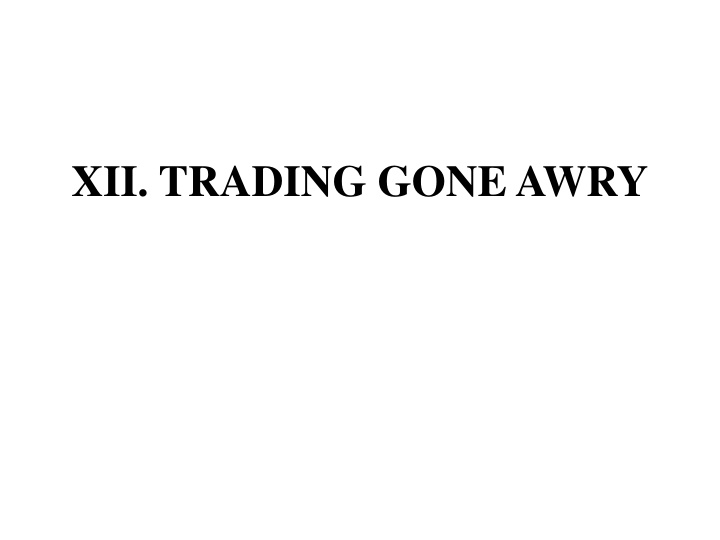


![Guardians of Collection Enhancing Your Trading Card Experience with the Explorer Sleeve Bundle [4-pack]](/thumb/3698/guardians-of-collection-enhancing-your-trading-card-experience-with-the-explorer-sleeve-bundle-4-pack.jpg)


